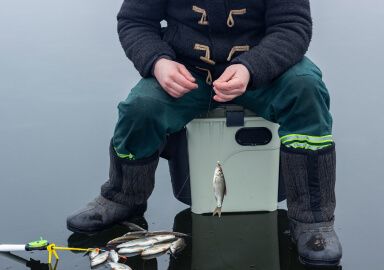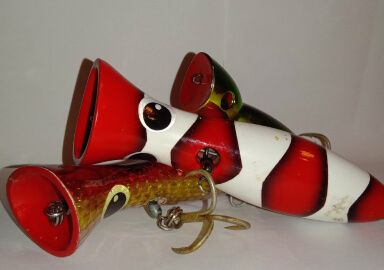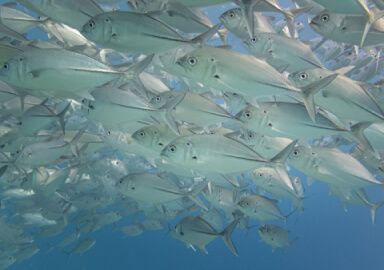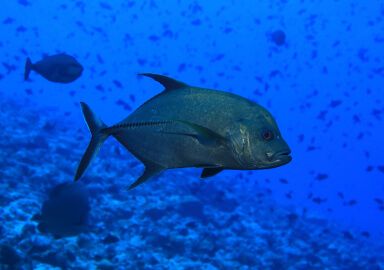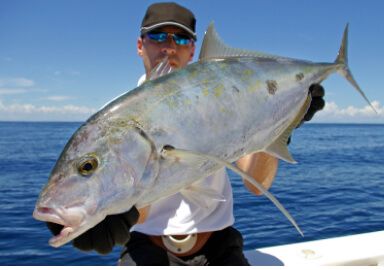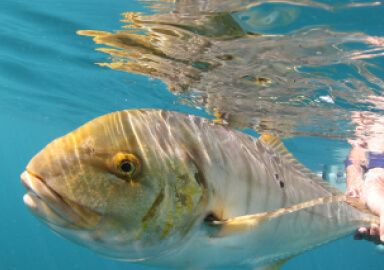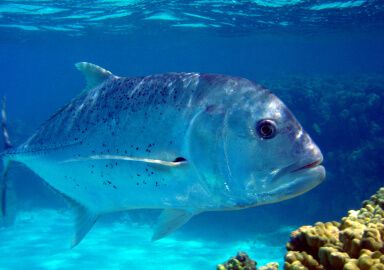Bluefin Trevally
Bluefin trevally are a brightly coloured, medium sized predatory fish of the warmer marine areas of the Indo-Pacific region.
View 17 listings
17
listings
–
price starting from
9
countries
–
to the nearest trip
Where and When?
Bluefin trevally are found in the Indian and Pacific Oceans from the east African shores across to California and South America. They are also common around much of the Australian coast and can be abundant around oceanic archipelagos such as Hawaii. They are generally an inshore species, especially when young, but are also occasionally found in the open ocean and up estuaries where the salinity is around or above 6.5 parts per thousand.
Juveniles mostly stay close inshore in estuaries, bays, seagrass beds or around inshore reefs. As they grow, they tend to move offshore, but fully mature specimens also often “raid” inshore areas in search of food. They can be found in the shallows and have been recorded down to 183 m. (600 ft.) and may be found throughout the water column. They are constantly on the move and seem to patrol reefs and structures continuously in search of food. They feed more voraciously in the warmer months and tend to move to deeper water in winters. They feed well in daylight, but may also be caught in late afternoon, early morning or even at night.
About Bluefin Trevally
The bluefin trevally (Caranx melampygus) is a popular member of the Carangidae (Jacks and Kingfishes) family. They have an oblong, compressed body, like many carangids, but with a fairly sharp-pointed snout. In the wild they have a bright, electric blue appearance, in particular on the fins and towards the rear of the fish, but this rapidly fades after capture. Otherwise, the body is a brassy-brown colour with black spots on the back that increase in number with age.
The sexes are similar, but the males are slightly larger. They can attain 117 cm. (46 in.) and 43.5 kg. (96 lbs.), but are more common around 80 cm. (31 in.) and mature at 30-40 cm. (12-16 in.). Juveniles eat mostly fish and invertebrates, but, as they grow, fish begin to dominate their food. They can be seen singly, in small groups or in medium to large shoals, especially when approaching the spawning season. Bluefin trevallies are multiple-spawners - at least in captivity - being able to spawn up to 8 times per year with a female being known to produce over 6 000 000 eggs in a year.
How to Catch?
Bluefin trevally are an extremely obvious and colourful fish and are also a firm favourite with many gamefish anglers. While all the usual methods can be used, they are particularly popular with fly fishers and also anglers using light spinning equipment. They may be caught from boats, but the most exciting fishing is probably working your way along a rocky shore or casting towards a rocky or coral reef and retrieving rapidly. The fish often “hide” in the turbulent white water and dart out to grab prey. Casting a fly, lure or floating bait into, or just beside, a turbulent area can result in an explosive hook up. Adults feed mostly on fast moving fish and so any bait, fly, or lure, if it is retrieved quickly in the right area, can entice a bluefin trevally to attack. If hooked, they are dogged, dirty fighters and will often head strongly for the only patch of rock or cover nearby. There is great satisfaction in landing a good-sized bluefin trevally but, if kept, the amazing colours soon vanish and you may wish you had released the fish. Bluefin kingfish are truly a worthy and impressive opponent.




